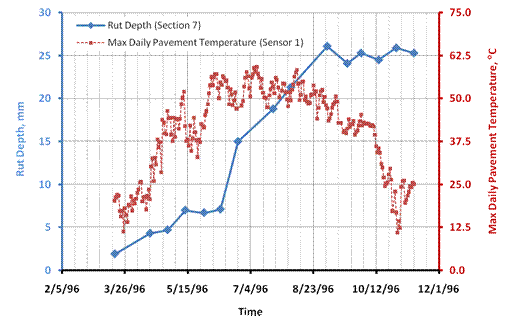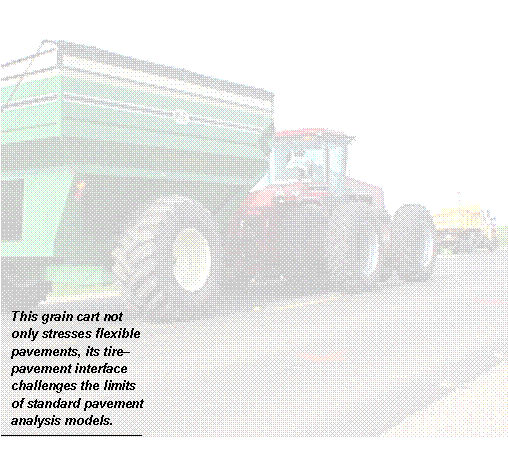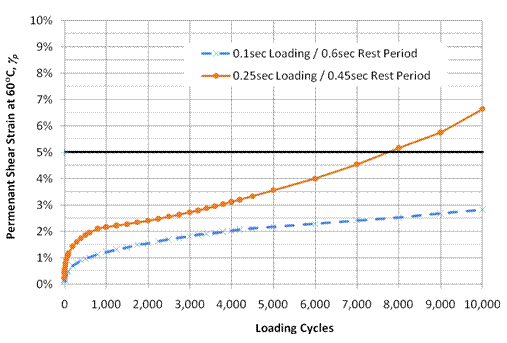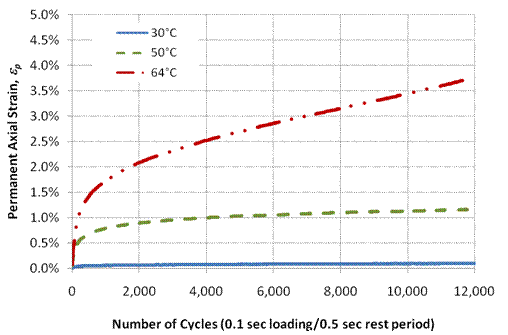

|
Designing Hot Mix Asphalt Pavements for a Variety of Loading Conditions: Three Case Studies continued |
|
CASE STUDY 1: Design of HMA Mixtures for Traffic Loadings at Intersections and Off-ramps The Nevada Department of Transportation, like other state highway agencies, has been working to improve the long-term performance of its HMA mixtures. In the past several years, NDOT has optimized the design of HMA mixtures through the use of aggregate gradations and asphalt binder grades that best suit Nevada’s traffic and environmental conditions. The recent population boom throughout the state, however, has presented the Nevada DOT with a new challenge, as the intersections and off-ramps have started showing severe rutting and shoving failures. To design HMA mixtures that can resist rutting and shoving at intersections and off-ramps, it was necessary to define the new loading conditions and to develop criteria for HMA mixtures for these locations. HMA mixtures that have performed well under highway loadings (i.e. fast loading rate) have failed at the intersections and off-ramps because the slow loading rate during the hot season presented a different set of conditions for these mixtures. It is believed that the HMA mixtures have reached their critical conditions, and therefore, failed. CASE STUDY 2: Accelerated Rutting of Test Sections at Westrack at High Pavement Temperatures Westrack, an experimental road test facility located 60 miles (100km) southeast of Reno, Nevada, is used for pavement load testing under controlled conditions. As pavement temperatures reached new highs during July and August 1996, rutting accelerated. In this case, as the loading rate on the 1.8-mile (2.9 km) oval track was kept constant at the same number of trucks per hour and truck speed of 40 mph, the elevated temperature created a critical condition for the HMA mix. The rut depth increased from 7mm to 26mm as the temperature of the pavement
The cases of intersections and off-ramps and Westrack both demonstrate that HMA mixtures experience severe rutting failures if their critical conditions are exceeded. The figures below illustrate this phenomenon on laboratory mixtures, showing the impacts of changing the loading rate and temperature on the permanent deformation behavior of HMA mixtures in the Superpave shear test (SST) and the repeated load triaxial test (RLT). The relationship in the first figure below represents the situation at the Nevada intersection and off-ramps (constant temperature with variable loading rate), while the relationship in the second figure represents the situation at the Westrack sections (constant loading rate with variable temperature).
CASE STUDY 3: Analysis of Impact of Heavy Agricultural Vehicles on State Highways In 1992 the agricultural community asked the South Dakota Department of Transportation (SDDOT) to allow the transport of agricultural vehicles over the state highway system. South Dakota is among a number of midwestern states for which this is an issue. As the SDDOT attempted to assess the damage caused by such vehicles, it was faced with the limitations of the available pavement analysis models. The grain cart is one of the vehicles that needed to be analyzed, along with Terragators (two models), tracked tractors, and road scrapers. The grain cart carries 50,000 pounds on two tires inflated to 30 psi. It travels at 20 mph. The distribution of stresses at the tire–pavement interface (shown in the figure below) represented a significant challenge for the commonly used pavement analysis models, which can only handle stationary circular and uniform stress distributions. For this SDDOT study, the University of Nevada researchers used the 3D-MOVE pavement analysis model, which is capable of handling any geometry of non-uniform stress distribution moving at any speed. By using the 3D-MOVE analysis, the UNR researchers were able to model the impact of the loaded grain cart and the other vehicles on flexible pavements during different seasons. These analyses provided the South Dakota DOT with the data necessary to support their load limits on agricultural vehicles. Recently, David Huft, an SDDOT research engineer stated, “Based on the results of our study with the University of Nevada, South Dakota maintained its rules subjecting agricultural vehicles to the same laws as other vehicles. The only exception is an allowance of five percent for products hauled from field to farm or elevator.” The full report, “Effect of Off-Road Tires on Flexible and Granular Pavements,” is available from the Western Regional Superpave Center. Click here.
Conclusion The two complementary ARC elements, Critically Designed HMA Mixtures and Pavement Response Model to Dynamic Loads (3D-MOVE), work together to support the development of a laboratory test and a pavement analysis model that can be used to assess the impact of unique loading conditions on HMA pavements. The research on the critically designed HMA mixtures will identify the critical combination of temperature and loading rate for every HMA mix. The research on the pavement response model to dynamic loads will offer the industry a process by which to assess whether the HMA mix is being subjected to its critical conditions. Using the recommendations drawn from these two efforts, the HMA pavement industry will be able to avoid placing HMA mixtures in situations where their critical conditions may be encountered. ARC |


|
Permanent shear strain versus number of loading cycles at 60°C for different loading rates. |
|
Permanent axial strain versus number of loading cycles at different temperatures. |
|
Rut depth and maximum pavement temperature as a function of time at Westrack. |

|
increased from 40 to 55oC. Again, the constant loading rate coupled with the increased pavement temperature generated the critical conditions for this Westrack mix. |
|
To remove your name from our mailing list, please click here. Questions or comments? E-mail us at psebaaly@unr.edu or call 775-784-6565. |